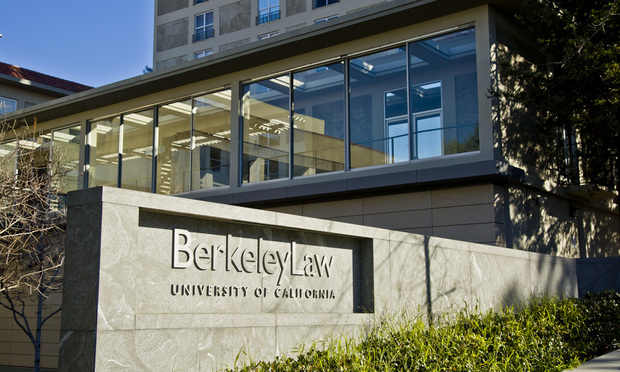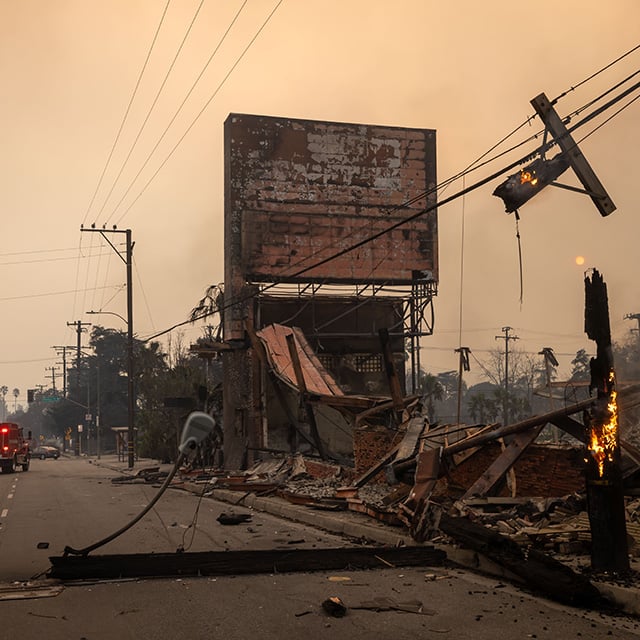Berkeley Law Returns to the U.S. News' Top 10, Pepperdine Gets Shut Out
The closely watched law school rankings offer few surprises this year, save for a decision to temporarily delist Pepperdine University School of Law for an data reporting mistake.
March 20, 2018 at 12:01 AM
6 minute read
The original version of this story was published on Law.com
 University of California, Berkeley School of Law.
University of California, Berkeley School of Law.
The University of California, Berkeley School of Law is one of the big winners in this year's U.S. News & World Report law school rankings, released Tuesday.
Berkeley moved up three spots to No. 9, regaining its position in among the top 10 schools—a perch it temporarily lost last year when it slipped four positions to No. 12. Otherwise, the new list offers relatively little drama among the elite schools.
Yale retained its longstanding spot at No. 1, followed by Stanford Law School at No. 2, and Harvard Law School at No. 3. There were no changes in rank among the top eight schools. Harvard is followed by the University of Chicago Law School; Columbia Law School; New York University School of Law; the University of Pennsylvania Law School; and the University of Michigan Law School.
The University of Virginia School of Law fell one spot to tie Berkeley at No. 9. While Duke Law School and Northwestern University Pritzker School of Law—which each tied at No. 10 last year—both lost one spot to land just outside the top 10.
Berkeley officials attributed the school's previous ranking decline to fallout from former dean Sujit Choudhry's sexual harassment controversy. Its strong performance this year can be attributed to a slight increase in the school's Law School Admission Test scores, as well as an uptick in graduates with jobs lined up at graduation.
Berkeley's restoration to U.S. News' top 10 wasn't the only triumph this year for the Bay Area school's current dean, Erwin Chemerinsky. The University of California, Irvine School of Law, where Chemerinsky was dean until this fall, rose seven spots to No. 21. The Orange County school is now tantalizingly close to cracking the top 20, which Chemerinsky set as an ambitious goal when he founded the school in 2007. (Irvine debuted in the rankings at No. 30 in 2015.)
“I have a skepticism about rankings, but my goal from the outset was that UCI Law School be in the top 20 and I am thrilled to see it ranked 21,” Chemerinsky said. “It reflects its terrific faculty, students, and program.”
U.S. News' annual rankings are always met with complaints from legal educators who charge that they take a one-size-fits-all approach to measuring law schools and don't accurately reflect the quality of each school. But law deans are also loath to ignore the rankings, which play an outsized role in the admissions landscape. Unlike business schools, which are ranked by multiple national publications, U.S. News is the only major player in law school rankings.
This year's list has a little extra controversy.
U.S. News removed Pepperdine University School of Law from the ranking after the school reported a mistake in the median LSAT score it provided to the publication. According to Pepperdine law dean Paul Caron, the school last week realized that it had incorrectly reported its median LSAT score as 162 instead of the correct 160 when it saw the early embargoed version of the rankings that U.S. News provides each school for review. (The initial ranking had Pepperdine moving up from No. 72 to No. 59.)
Rather than recalculate the school's rank and issue a new list prior to the official release, as the Caron requested, U.S. News removed Pepperdine's ranking altogether.
“It is, of course, deeply disappointing to be unranked for a year,” Caron wrote in a post on his Tax Prof Blog. “But the reality is that we made great progress in the rankings this year, and should continue our ascent next year.”
Caron said several experts concluded that Pepperdine would have ranked 62nd or 64th using the correct median LSAT.
University of Chicago law professor Brian Leiter, a frequent critic of law school rankings, said on his blog that U.S. News' handling of the situation will dissuade law schools from disclosing any inadvertent mistakes in their data.
“No good deed goes unpunished by [U.S. News Chief Data Strategist] Bob Morse & Co.,” Leiter wrote.
Morse said that U.S. News handles misreported data on a case-by-case basis.
“It is worth noting that Pepperdine did complete the data verification process during the data collection for law schools, assuring U.S. News that its information was accurate,” Morse said. “We do rely on schools to accurately report their information, and we thank them for their cooperation and efforts in doing just that.”
As is typical, most of the major moves among schools occurred outside of the top 50.
The second-largest jump this year was Santa Clara University School of Law which shot up 19 spots to become No. 113, due in part to an improved median undergraduate grade-point average, and better graduate employment and bar pass rates.
“We are excited by our momentum, including the debut of [the school's new campus] Charney Hall,” said law dean Lisa Kloppenberg. “The increase reflects our emphasis on preparing students well for our market and improving employment opportunities, plus greater support from the university, alumni and friends.”
Among the major decliners was The University of San Diego School of Law, down 18 spots to No. 95.
U.S. News' methodology largely stayed the same this year, though it “slightly reduced” the discount it applies to graduate jobs that are funded by the law schools themselves in its calculation of employment rates.
Forty percent of each school's ranking is based on reputational assessments by legal academics, lawyers and judges. The median LSAT score and undergraduate grade-point averages account for another 25 percent, while job placement and bar pass rates are 20 of a school's score. Faculty resources comprise the final 15 of each school's rank.
This content has been archived. It is available through our partners, LexisNexis® and Bloomberg Law.
To view this content, please continue to their sites.
Not a Lexis Subscriber?
Subscribe Now
Not a Bloomberg Law Subscriber?
Subscribe Now
NOT FOR REPRINT
© 2025 ALM Global, LLC, All Rights Reserved. Request academic re-use from www.copyright.com. All other uses, submit a request to [email protected]. For more information visit Asset & Logo Licensing.
You Might Like
View All
'A Death Sentence for TikTok'?: Litigators and Experts Weigh Impact of Potential Ban on Creators and Data Privacy

Shareholder Democracy? The Chatter Musk’s Tesla Pay Case Is Spurring Between Lawyers and Clients
6 minute read

Many LA County Law Firms Remain Open, Mobilize to Support Affected Employees Amid Historic Firestorm
Trending Stories
- 1'A Death Sentence for TikTok'?: Litigators and Experts Weigh Impact of Potential Ban on Creators and Data Privacy
- 2Bribery Case Against Former Lt. Gov. Brian Benjamin Is Dropped
- 3‘Extremely Disturbing’: AI Firms Face Class Action by ‘Taskers’ Exposed to Traumatic Content
- 4State Appeals Court Revives BraunHagey Lawsuit Alleging $4.2M Unlawful Wire to China
- 5Invoking Trump, AG Bonta Reminds Lawyers of Duties to Noncitizens in Plea Dealing
Who Got The Work
J. Brugh Lower of Gibbons has entered an appearance for industrial equipment supplier Devco Corporation in a pending trademark infringement lawsuit. The suit, accusing the defendant of selling knock-off Graco products, was filed Dec. 18 in New Jersey District Court by Rivkin Radler on behalf of Graco Inc. and Graco Minnesota. The case, assigned to U.S. District Judge Zahid N. Quraishi, is 3:24-cv-11294, Graco Inc. et al v. Devco Corporation.
Who Got The Work
Rebecca Maller-Stein and Kent A. Yalowitz of Arnold & Porter Kaye Scholer have entered their appearances for Hanaco Venture Capital and its executives, Lior Prosor and David Frankel, in a pending securities lawsuit. The action, filed on Dec. 24 in New York Southern District Court by Zell, Aron & Co. on behalf of Goldeneye Advisors, accuses the defendants of negligently and fraudulently managing the plaintiff's $1 million investment. The case, assigned to U.S. District Judge Vernon S. Broderick, is 1:24-cv-09918, Goldeneye Advisors, LLC v. Hanaco Venture Capital, Ltd. et al.
Who Got The Work
Attorneys from A&O Shearman has stepped in as defense counsel for Toronto-Dominion Bank and other defendants in a pending securities class action. The suit, filed Dec. 11 in New York Southern District Court by Bleichmar Fonti & Auld, accuses the defendants of concealing the bank's 'pervasive' deficiencies in regards to its compliance with the Bank Secrecy Act and the quality of its anti-money laundering controls. The case, assigned to U.S. District Judge Arun Subramanian, is 1:24-cv-09445, Gonzalez v. The Toronto-Dominion Bank et al.
Who Got The Work
Crown Castle International, a Pennsylvania company providing shared communications infrastructure, has turned to Luke D. Wolf of Gordon Rees Scully Mansukhani to fend off a pending breach-of-contract lawsuit. The court action, filed Nov. 25 in Michigan Eastern District Court by Hooper Hathaway PC on behalf of The Town Residences LLC, accuses Crown Castle of failing to transfer approximately $30,000 in utility payments from T-Mobile in breach of a roof-top lease and assignment agreement. The case, assigned to U.S. District Judge Susan K. Declercq, is 2:24-cv-13131, The Town Residences LLC v. T-Mobile US, Inc. et al.
Who Got The Work
Wilfred P. Coronato and Daniel M. Schwartz of McCarter & English have stepped in as defense counsel to Electrolux Home Products Inc. in a pending product liability lawsuit. The court action, filed Nov. 26 in New York Eastern District Court by Poulos Lopiccolo PC and Nagel Rice LLP on behalf of David Stern, alleges that the defendant's refrigerators’ drawers and shelving repeatedly break and fall apart within months after purchase. The case, assigned to U.S. District Judge Joan M. Azrack, is 2:24-cv-08204, Stern v. Electrolux Home Products, Inc.
Featured Firms
Law Offices of Gary Martin Hays & Associates, P.C.
(470) 294-1674
Law Offices of Mark E. Salomone
(857) 444-6468
Smith & Hassler
(713) 739-1250






